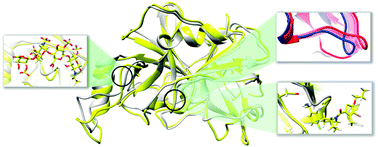Heparin makes differences: a molecular dynamics simulation study on the human βII-tryptase monomer†
Abstract
Human β-tryptase, an enzyme with trypsin-like activity in mast cells, is an important target for the treatment of inflammatory and allergy related diseases. Heparin has been inferred to play a vital role in the stabilization of the tryptase structure and the maintenance of its active form. Up to now, the structure–function relationship between heparin and the βII-tryptase monomer has not been studied with atomic resolution due to the lack of a complex structure of tryptase and heparin. To this end, the exact effect of heparin bonding to the βII-tryptase monomer structure has been investigated using molecular docking and molecular dynamics (MD) simulation. The MD simulation results combined with MM-GB/SA calculations showed that heparin stabilized the β-tryptase structure mainly through salt bridge interaction. The averaged noncovalent interaction (aNCI) method was employed for the visualization of nonbonding interactions. A crucial loop, which is located in the core region of βII-tryptase monomer structure, has been found. Arg188 and Asp189 from this loop act as a salt bridge intermediary between 4-mer heparin and 0GX. The observation of a salt bridge between Asp189 and P1 groups of 0GX confirms the supposed interaction between these two groups. These two residues have been proved to be responsible for the direction of the P1 group of 0GX. Our study revealed that how heparin affected the activity of the human βII-tryptase monomer (hBTM) through salt bridge interactions. The knowledge of heparin binding characteristics and the key residue contributions in this study may enlighten further the inhibitor design of this enzyme and may also improve our understanding of inflammatory and allergy related diseases.


 Please wait while we load your content...
Please wait while we load your content...